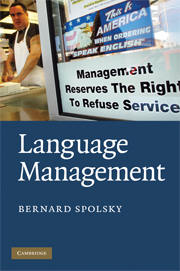Book contents
- Frontmatter
- Contents
- Acknowledgements
- 1 Towards a theory of language management
- 2 Managing language in the family
- 3 Religious language policy
- 4 Language management in the workplace: managing business language
- 5 Managing public linguistic space
- 6 Language policy in schools
- 7 Managing language in legal and health institutions
- 8 Managing military language
- 9 Local, regional, and national governments managing languages
- 10 Influencing language management: language activist groups
- 11 Managing languages at the supranational level
- 12 Language managers, language management agencies and academies, and their work
- 13 A theory of language management: postscript or prolegomena
- References
- Index
7 - Managing language in legal and health institutions
Published online by Cambridge University Press: 05 June 2012
- Frontmatter
- Contents
- Acknowledgements
- 1 Towards a theory of language management
- 2 Managing language in the family
- 3 Religious language policy
- 4 Language management in the workplace: managing business language
- 5 Managing public linguistic space
- 6 Language policy in schools
- 7 Managing language in legal and health institutions
- 8 Managing military language
- 9 Local, regional, and national governments managing languages
- 10 Influencing language management: language activist groups
- 11 Managing languages at the supranational level
- 12 Language managers, language management agencies and academies, and their work
- 13 A theory of language management: postscript or prolegomena
- References
- Index
Summary
Safety and health
Legal and health institutions share a number of features that make it possible to consider them in a single chapter. Each has two distinct classes of participants: the professionals who control the domain and the lay public who come into contact with them. Even without other causes of language difficulty (such as the fact that lawyers, judges, police, doctors, and nurses are generally majority language speakers and their clients or patients come from all classes and usually include a high proportion of minority language speakers), the gap between professional and lay varieties of language is a critical issue. An early study of doctor–patient communication in Britain showed that it was not just foreign medical personnel who caused problems: most patients surveyed asked the nurse on the way out “What did he say?” Obviously, the lay/professional difference is greatly exacerbated when it also encounters a language barrier. But communication is critical in these domains: a doctor must understand what a patient is feeling, a patient must understand what the doctor recommends or requires, and justice demands that police, judges, jury, witnesses, and accused all understand each other.
That at least is the view from the outside, but if it were shared by all those who control legal and health institutions, the domains would be self-regulating. Rather, they have acted (and in many cases still act) with less than full responsibility.
- Type
- Chapter
- Information
- Language Management , pp. 115 - 128Publisher: Cambridge University PressPrint publication year: 2009



